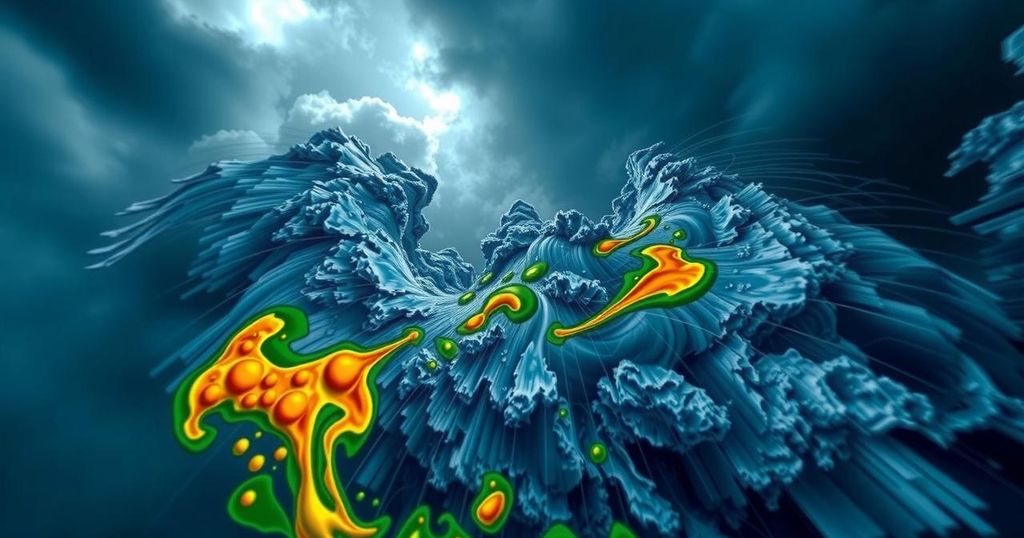Analyzing Hurricane Oscar: The Forecasting Shortfall and Swift Response

Hurricane Oscar rapidly intensified from a tropical wave with a 10% chance of development into a Category 1 hurricane impacting the Bahamas within a day. Traditional computer models failed to forecast this change, yet human observation and on-site reconnaissance enabled timely warnings and preparation.
On Friday evening, a disorganized tropical wave positioned east of Puerto Rico faced a mere 10% likelihood of developing into a stronger system over the weekend. However, by Saturday afternoon, this wave intensified into Hurricane Oscar, a Category 1 hurricane, poised to impact the Bahamas. This sudden escalation caught many major storm models off guard, yet dedicated meteorologists and aircraft teams observed the unfolding data and alerted the public of the impending storm before it made landfall. Philippe Papin, the forecaster on duty at the National Hurricane Center, became aware of potential issues while examining satellite imagery, which revealed a concerning low-level swirl indicative of tropical development. Papin remarked, “It became pretty clear that a small circulation was developing.” Armed with this information, the hurricane center swiftly issued its first forecast for Tropical Storm Oscar by 11 a.m., pointing toward the Bahamas and Cuba, prompting the Bahamas to issue a tropical storm warning. Simultaneously, a designated crew of Hurricane Hunters took flight from St. Croix. Their efforts identified a significantly altered system compared to earlier observations. Remarkably, it was not until they were approximately ten nautical miles from the storm’s center that the plane detected winds consistent with a tropical storm. By 2 p.m., Tropical Storm Oscar had escalated to Hurricane Oscar, noted as one of the smaller hurricanes recorded in the Caribbean region, leaving less than a day for the islands to prepare for the approaching storm. Papin commented on the urgency of the situation, stating, “The typical time for issuing a watch is 48 hours of lead time. This was more like 12 to 24 hours. Obviously, that is suboptimal.” Ultimately, Hurricane Oscar made landfall on Great Inagua Island in the Bahamas on Sunday morning, subsequently affecting the eastern coast of Cuba in the evening. The trajectory that led to Oscar’s formation began more than a week prior, as the system emerged off the coast of Africa. Initial assessments by computer models suggested a potential for developing into a tropical depression, or stronger system. However, a surge of dry air reportedly diminished its prospects, leading models to disregard its viability. By Friday, no significant hurricane models anticipated a tropical storm development in the Caribbean or Atlantic for the following week. “When models had signals of development, they ultimately dismissed them,” clarified Phil Klotzbach, senior research scientist at Colorado State University. The reconnaissance data collected during the Hurricane Hunters’ flight was subsequently integrated into computer models, which began to align with Oscar’s development by mid-afternoon, recognizing the storm’s small physical size and localized hurricane-force winds extending only five nautical miles from its center. Despite its diminutive nature, Oscar’s classification as a hurricane was confirmed Saturday, although its radius of hurricane-force winds measured 34 nautical miles, a size that does not parallel the records set by other minor storms tracked since 2004. Klotzbach noted the difficulty in forecasting such small storms, stating, “These small storms are tricky.” Such instances underline the inherent complexities of predicting tropical storm behavior and the critical nature of field reconnaissance in refining forecasts effectively.
The article discusses the rapid intensification of a tropical wave into Hurricane Oscar, highlighting the challenges faced by computer models in predicting its development. It examines how real-time data collection and meteorological observation play a crucial role in forecasting storms, especially when traditional models overlook significant atmospheric signals. The piece provides insights into the dynamics of hurricane formation and underscores the importance of timely alerts for effective disaster preparedness in vulnerable regions, particularly the Bahamas and Cuba.
In summary, Hurricane Oscar’s unexpected development from a tropical wave into a hurricane showcases the limitations of computer models in forecasting small storm systems. The efficient response by forecasters, aided by real-time reconnaissance data, played a pivotal role in issuing timely warnings for the affected regions. The case of Oscar highlights not only the complexities involved in tropical storm prediction but also the critical need for human expertise alongside technological advancements in meteorology.
Original Source: www.tampabay.com








